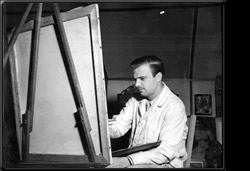BEACON AND STORM: THE ART OF TRISTAN MEINECKE
I first encountered the work of Tristan Meinecke in the World Surrealist Exhibition in Chicago in 1976, a densely packed show in an old carriage barn on Illinois Street where Tristan’s wall-sized assemblage “Amerika” (retitled “The Domain of T-Bone Slim”) stood out among a wealth of unusual and very original art. “Amerika” absorbed an astounding array of battered and castaway objects including hats, helmets, boots, chair legs, hammered metal, torn canvas, and, most memorably, the headboard of a decrepit brass bed. A couple years later I visited Tristan's studio with Franklin  Rosemont (who played a significant role in Tristan's inclusion in the 1976 show as well as Tristan’s growing involvement in Chicago surrealism). The revelation of this visit appeared in works of smaller dimension than “Amerika”, works which, nonetheless, quickly demonstrated the sheer force of his imagination, his inspired celebration of surging transformation, and what seemed to me, then and now, a startling willingness to embrace chaotic power. Tristan guided us among work spanning several decades, a tour that included descriptions of other activities, from architecture to new experiments in “physical piano.” The saga of his life and interests unfolded exponentially: his wife Angel Casey’s 1950’s television show for which he provided musical direction, a serious pursuit of jazz clarinet in the 1940s, a recent return to writing in the form of automatic poems “treating words as musical sounds.” Such intense and various passions were not exceptional among the many surrealists I encountered over these years in Chicago, but Tristan had maintained a remarkable level of accomplishment in every direction he took.
Rosemont (who played a significant role in Tristan's inclusion in the 1976 show as well as Tristan’s growing involvement in Chicago surrealism). The revelation of this visit appeared in works of smaller dimension than “Amerika”, works which, nonetheless, quickly demonstrated the sheer force of his imagination, his inspired celebration of surging transformation, and what seemed to me, then and now, a startling willingness to embrace chaotic power. Tristan guided us among work spanning several decades, a tour that included descriptions of other activities, from architecture to new experiments in “physical piano.” The saga of his life and interests unfolded exponentially: his wife Angel Casey’s 1950’s television show for which he provided musical direction, a serious pursuit of jazz clarinet in the 1940s, a recent return to writing in the form of automatic poems “treating words as musical sounds.” Such intense and various passions were not exceptional among the many surrealists I encountered over these years in Chicago, but Tristan had maintained a remarkable level of accomplishment in every direction he took.
It was a period in my life, beginning with my own first exhibitions with the Chicago group, in which many of my own seemingly divergent interests were finding cross-pollination and fruition in unexpected ways. I was very proud to have my drawings, collages, and writings, published and exhibited alongside an artist of such integrity, dedication, and courage.
 In “A Short Essay on Two Minds” in 1946 Tristan Meinecke wrote: “My mind seems ever to be precariously poised upon the space-defying brink of the chasm of indecision.” While nothing in the painting, sculpture, music, and poetry of Tristan Meinecke offers any evidence of indecision, this compounding of “brink” and “chasm” in an image of precarious poise summons all the dizzying conflicts barely contained in his powerful works. In fact, Tristan’s often breathtaking rendering of shape and chaos reveal battles of Blakean proportions, the seismic shifts of colossal Energies, Prolific and Devouring, the eternal struggles of Unnamed Forms Blake witnesses in the Printing House in Hell. Belied by seemingly innocent play with the formal rectangles (emblematic of Newton and Urizen) of conventional framing, the reality of such tyrannies rarely won out in Meinecke’s battle with contemporary picture-making. Tristan Meinecke’s work, compiled with stunning confidence in his own powers to summon and compose, images both beacon and storm, counsel us in the deepest uncertainties of the new century.
In “A Short Essay on Two Minds” in 1946 Tristan Meinecke wrote: “My mind seems ever to be precariously poised upon the space-defying brink of the chasm of indecision.” While nothing in the painting, sculpture, music, and poetry of Tristan Meinecke offers any evidence of indecision, this compounding of “brink” and “chasm” in an image of precarious poise summons all the dizzying conflicts barely contained in his powerful works. In fact, Tristan’s often breathtaking rendering of shape and chaos reveal battles of Blakean proportions, the seismic shifts of colossal Energies, Prolific and Devouring, the eternal struggles of Unnamed Forms Blake witnesses in the Printing House in Hell. Belied by seemingly innocent play with the formal rectangles (emblematic of Newton and Urizen) of conventional framing, the reality of such tyrannies rarely won out in Meinecke’s battle with contemporary picture-making. Tristan Meinecke’s work, compiled with stunning confidence in his own powers to summon and compose, images both beacon and storm, counsel us in the deepest uncertainties of the new century.
- Hal Rammel, August 2003
[Catalog essay for “Tristan Meinecke: Heterogeneous Forms. A Selection of Works 1935-2000,” 1926 Exhibition Studies Space, Chicago, Illinois, September 2003; co-curated by John Corbett and Hal Rammel. This exhibit of paintings was also shown at Woodland Pattern Book Center/Gallery, Milwaukee, Wisconsin; January 2004.]
TOP